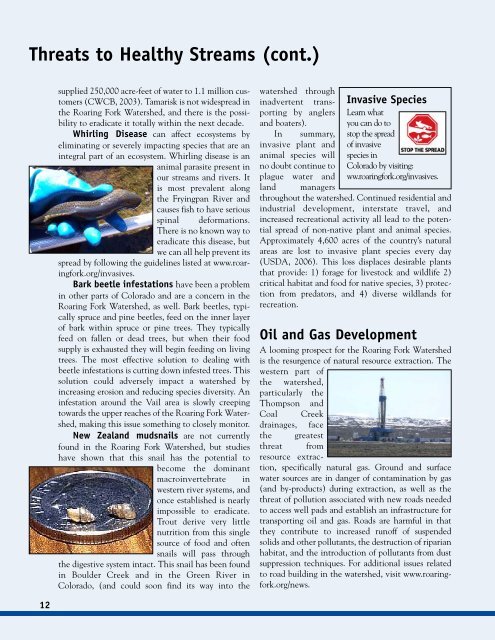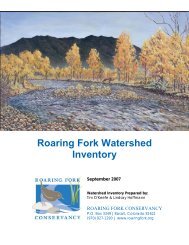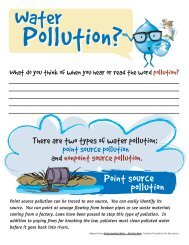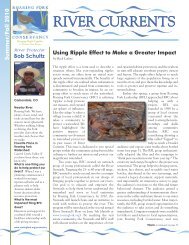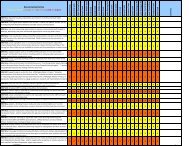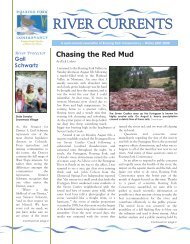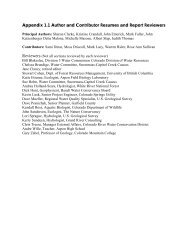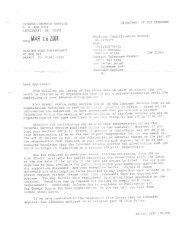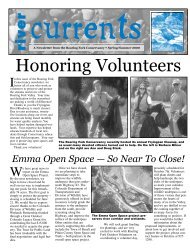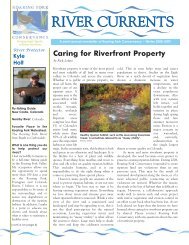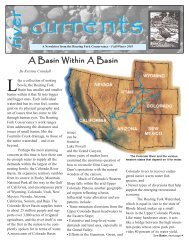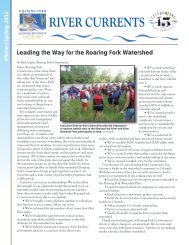2006 Roaring Fork Watershed Water Quality Report
2006 Roaring Fork Watershed Water Quality Report
2006 Roaring Fork Watershed Water Quality Report
- No tags were found...
Create successful ePaper yourself
Turn your PDF publications into a flip-book with our unique Google optimized e-Paper software.
Threats to Healthy Streams (cont.)supplied 250,000 acre-feet of water to 1.1 million customers(CWCB, 2003). Tamarisk is not widespread inthe <strong>Roaring</strong> <strong>Fork</strong> <strong><strong>Water</strong>shed</strong>, and there is the possibilityto eradicate it totally within the next decade.Whirling Disease can affect ecosystems byeliminating or severely impacting species that are anintegral part of an ecosystem. Whirling disease is ananimal parasite present inour streams and rivers. Itis most prevalent alongthe Fryingpan River andcauses fish to have seriousspinal deformations.There is no known way toeradicate this disease, butwe can all help prevent itsspread by following the guidelines listed at www.roaringfork.org/invasives.Bark beetle infestations have been a problemin other parts of Colorado and are a concern in the<strong>Roaring</strong> <strong>Fork</strong> <strong><strong>Water</strong>shed</strong>, as well. Bark beetles, typicallyspruce and pine beetles, feed on the inner layerof bark within spruce or pine trees. They typicallyfeed on fallen or dead trees, but when their foodsupply is exhausted they will begin feeding on livingtrees. The most effective solution to dealing withbeetle infestations is cutting down infested trees. Thissolution could adversely impact a watershed byincreasing erosion and reducing species diversity. Aninfestation around the Vail area is slowly creepingtowards the upper reaches of the <strong>Roaring</strong> <strong>Fork</strong> <strong><strong>Water</strong>shed</strong>,making this issue something to closely monitor.New Zealand mudsnails are not currentlyfound in the <strong>Roaring</strong> <strong>Fork</strong> <strong><strong>Water</strong>shed</strong>, but studieshave shown that this snail has the potential tobecome the dominantmacroinvertebrate inwestern river systems, andonce established is nearlyimpossible to eradicate.Trout derive very littlenutrition from this singlesource of food and oftensnails will pass throughthe digestive system intact. This snail has been foundin Boulder Creek and in the Green River inColorado, (and could soon find its way into thewatershed throughinadvertent transportingby anglersand boaters).In summary,invasive plant andanimal species willno doubt continue toplague water andInvasive SpeciesLearn whatyou can do tostop the spreadof invasivespecies inColorado by visiting:ww.roaringfork.org/invasives.land managersthroughout the watershed. Continued residential andindustrial development, interstate travel, andincreased recreational activity all lead to the potentialspread of non-native plant and animal species.Approximately 4,600 acres of the country’s naturalareas are lost to invasive plant species every day(USDA, <strong>2006</strong>). This loss displaces desirable plantsthat provide: 1) forage for livestock and wildlife 2)critical habitat and food for native species, 3) protectionfrom predators, and 4) diverse wildlands forrecreation.Oil and Gas DevelopmentA looming prospect for the <strong>Roaring</strong> <strong>Fork</strong> <strong><strong>Water</strong>shed</strong>is the resurgence of natural resource extraction. Thewestern part ofthe watershed,particularly theThompson andCoal Creekdrainages, facethe greatestthreat fromresource extraction,specifically natural gas. Ground and surfacewater sources are in danger of contamination by gas(and by-products) during extraction, as well as thethreat of pollution associated with new roads neededto access well pads and establish an infrastructure fortransporting oil and gas. Roads are harmful in thatthey contribute to increased runoff of suspendedsolids and other pollutants, the destruction of riparianhabitat, and the introduction of pollutants from dustsuppression techniques. For additional issues relatedto road building in the watershed, visit www.roaringfork.org/news.12


